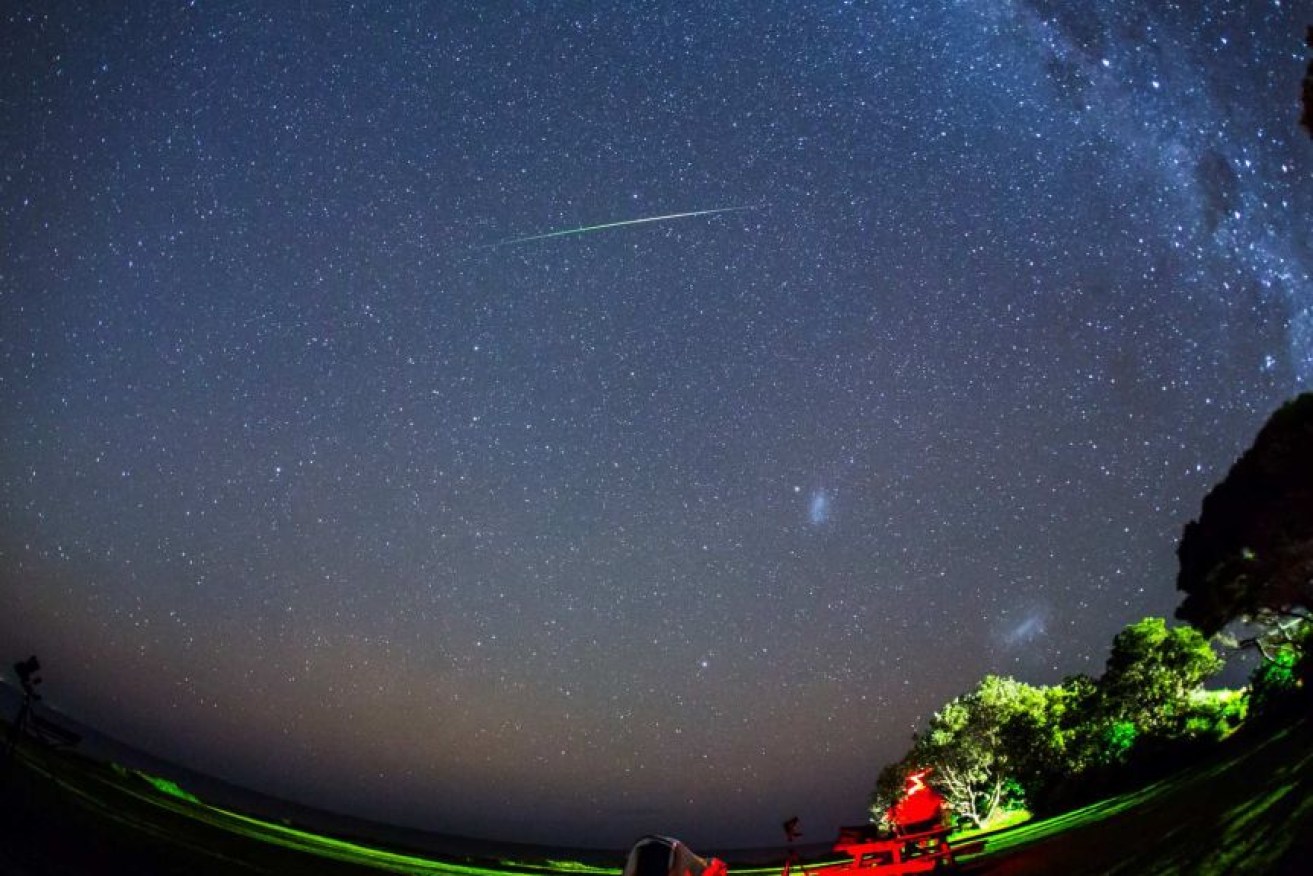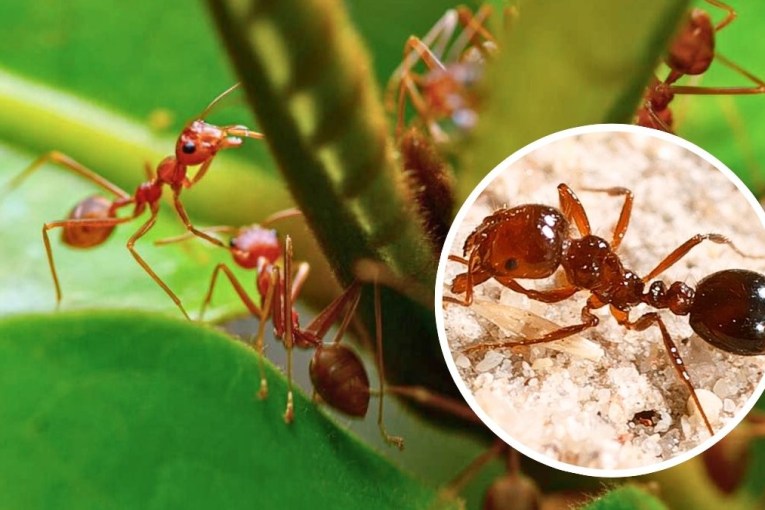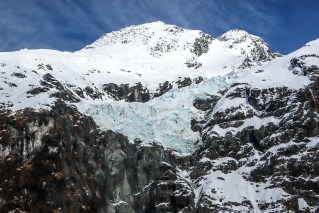Eta Aquariid meteor shower to light up Australian skies

Eta Aquariid meteor streaks across the night sky of Kiama. Photo: David Finlay/Clearskiestv
Rug up, set your alarm clock and get ready to see one of the best sky shows over Australia this week.
The Eta Aquariid meteor shower, which occurs every May, is one of the highlights of the year for seasoned sky watchers.
Unlike many other meteor showers, such as the recent Lyrids, it rewards sky watchers right across Australia with lots of bright meteors streaking across the sky.
This year the shower will peak on the morning of [Wednesday] May 6.
But if you sleep in – the best time to see them is between 2am and 5am – or the weather isn’t great, you can still see meteors a day or so before or after.
This year the Moon will affect your view a little, but with three bright planets in the sky it will still be an absolutely beautiful sight, said amateur astronomer Ian Musgrave.
“It’s going to a really nice night,” Dr Musgrave said.
“You’ve got the Milky Way spread out over your head and you’re looking down towards Jupiter, Saturn and Mars.
“If you are really lucky, you should see bright meteors going through the heart of the galaxy.”
If you have binoculars and live in a dark sky area you may also be able to catch Comet SWAN near the eastern horizon.

The radiant point of the Eta Aquariids and Comet SWAN as seen from Brisbane on May 6. Photo: Stellarium/Ian Musgrave
The Eta Aquariids meteor shower is created as Earth passes through the dust trail laid down by Halley’s Comet.
Halley’s Comet circles in towards us every 76 years from somewhere out beyond Pluto.
While it was last in our skies in 1986, the dust we are passing through is tens of thousands of years old, said Jonti Horner, an astronomer at the University of Southern Queensland.
And because its so old, it’s had time to spread out.
“So we cross through this meteor stream for more than a month from April 19 to May 28,” Professor Horner said.
We cross the stream again in October, which is when we see the Orionids meteor shower.
But Eta Aquariid meteor shower is more impressive because we pass through the guts of the dust stream during the peak so the rate of meteors is much higher.
What will you see where you live?
The Eta Aquariids come from a point in the zodiac constellation of Aquarius.
But you can’t see any meteors until the radiant point rises above the horizon.
Unlike many other meteor showers, the Eta Aquariids are best seen in the Southern Hemisphere, where the radiant is higher in the sky and the twilight is longer before sunrise at this time of year.
If you are very lucky, you can see spectacular Earth grazing meteors around the time the radiant rises.
“They’re coming into the atmosphere at a very shallow angle so they can burn across the sky for a really long time and go from horizon to horizon,” Professor Horner said.
“The number of meteors you’ll see is much lower than a couple of hours later, but the chance is you might just get a good one.”
The number of meteors you’ll see depends upon where you live in Australia.
You will see slightly more meteors per hour the further west you live because the radiant point is higher in the sky before sunrise.
So people living in Perth will see slightly more meteors than people living in similar latitudes such as Sydney and Canberra.
| Location | May 4 | May 5 | May 6 (peak) | May 7 | May 8 |
| Adelaide | 11/hr | 13/hr | 16/hr | 16/hr | 9/hr |
| Brisbane | 12/hr | 14/hr | 17/hr | 17/hr | 10/hr |
| Canberra | 11/hr | 13/hr | 16/hr | 16/hr | 9/hr |
| Darwin | 12/hr | 15/hr | 17/hr | 17/hr | 9/hr |
| Hobart | 10/hr | 12/hr | 14/hr | 15/hr | 9/hr |
| Melbourne | 11/hr | 13/hr | 15/hr | 16/hr | 9/hr |
| Perth | 11/hr | 14/hr | 16/hr | 16/hr | 9/hr |
| Sydney | 11/hr | 13/hr | 14/hr | 11/hr | 7/hr |
How to get the best view
Catching a meteor is a bit like catching buses – you may need to wait for a while, then several may come at once.
Once you’ve given your eyes a few minutes to adjust, start scanning the sky above the eastern horizon using Jupiter, Saturn and Mars as your signposts, Dr Musgrave said.
“If you look directly at the radiant – the spot where the meteors originate from – you won’t see any because the meteor burn starts away from the radiant,” he said.
“These good signposts make it easier to scan the sky area, where you should start to see the meteors start their burn so it’s going to be potentially easier to pick up the meteors even though you’ve got a bit of moonlight interference.”
The Moon is in its waxing phase so it doesn’t set until about an hour before sunrise, which will make it harder to see fainter meteors, especially later in the week.
“On the 6th it is going to be quite low at the time when the meteors will be the most abundant, so it should be fairly easy to block out the light of the Moon with a tree or object.”

Meteors will often have a green tinge as they streak across the sky. Photo: David Finlay/Clearskiestv
How to take a great photo of the meteor shower
Astrophotographer David Finlay has been capturing the beauty of meteor showers for 20 years.
Each year he looks forward to the Eta Aquariid meteor shower, along with the Geminids meteor shower, which occurs in December.
And right now, thanks to less air and light pollution, the skies are glorious from his backyard in Kiama, New South Wales.
“The stars are looking absolutely fantastic at the moment, so I’m trying to take advantage of it while I can,” Mr Finlay said.
“We’re basically getting the skies in the city that they get in the bush all the time.”
Here are his tips for taking a top shot using a standard DSLR camera
- Crank up the ISO as high as possible in the range of 3200 to 6400
- Use a wide-angle lens – between 24mm and 15mm is best
- The aperture needs to be as wide as it can go (the lowest number) to let in as much light as possible. “I use f1.4, but most lenses are around f2.8-f3.5,” he said.
- The Moon or ambient lighting can wash out photos so shoot continuously with a short shutter speed —10 or 15 seconds. “You’ll capture the meteors just as well with a shorter exposure, but you’ll have to take a lot more photos to capture them.”
- Use a bright star to manually focus the camera. “Sharp focus is so important. Most cameras now use live-view with a digital zoom.
While some photographers like to focus on the radiant point to take a composite series of meteors, Mr Finlay prefers to take wider shots that give more context, such as other celestial objects or the horizon.
“I think the best meteors are actually the opposite side of the sky, towards the south,” he said.
“I love getting the Large and Small Magellanic Clouds (other galaxies) or the centre of our Milky Way galaxy in the photo, or just point the camera so the bottom quarter shows the horizon and maybe even people sitting watching the shower.”
Having something in the foreground that is interesting like an old tree is also good, he added.
“I’ll probably be framing my photos to include the palm trees in my backyard.”








